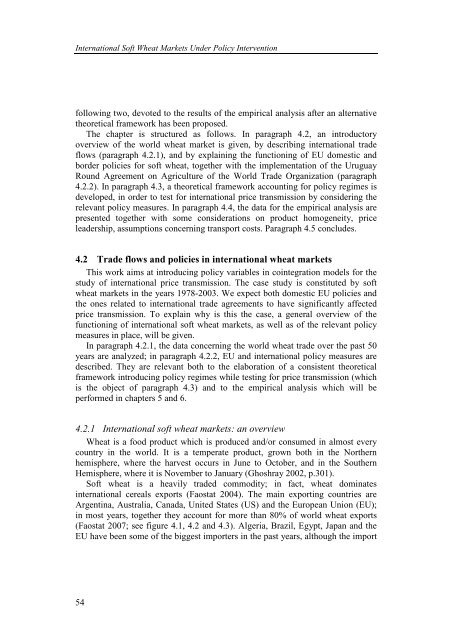TESTING INTERNATIONAL PRICE TRANSMISSION UNDER ...
TESTING INTERNATIONAL PRICE TRANSMISSION UNDER ...
TESTING INTERNATIONAL PRICE TRANSMISSION UNDER ...
Create successful ePaper yourself
Turn your PDF publications into a flip-book with our unique Google optimized e-Paper software.
International Soft Wheat Markets Under Policy Intervention<br />
following two, devoted to the results of the empirical analysis after an alternative<br />
theoretical framework has been proposed.<br />
The chapter is structured as follows. In paragraph 4.2, an introductory<br />
overview of the world wheat market is given, by describing international trade<br />
flows (paragraph 4.2.1), and by explaining the functioning of EU domestic and<br />
border policies for soft wheat, together with the implementation of the Uruguay<br />
Round Agreement on Agriculture of the World Trade Organization (paragraph<br />
4.2.2). In paragraph 4.3, a theoretical framework accounting for policy regimes is<br />
developed, in order to test for international price transmission by considering the<br />
relevant policy measures. In paragraph 4.4, the data for the empirical analysis are<br />
presented together with some considerations on product homogeneity, price<br />
leadership, assumptions concerning transport costs. Paragraph 4.5 concludes.<br />
4.2 Trade flows and policies in international wheat markets<br />
This work aims at introducing policy variables in cointegration models for the<br />
study of international price transmission. The case study is constituted by soft<br />
wheat markets in the years 1978-2003. We expect both domestic EU policies and<br />
the ones related to international trade agreements to have significantly affected<br />
price transmission. To explain why is this the case, a general overview of the<br />
functioning of international soft wheat markets, as well as of the relevant policy<br />
measures in place, will be given.<br />
In paragraph 4.2.1, the data concerning the world wheat trade over the past 50<br />
years are analyzed; in paragraph 4.2.2, EU and international policy measures are<br />
described. They are relevant both to the elaboration of a consistent theoretical<br />
framework introducing policy regimes while testing for price transmission (which<br />
is the object of paragraph 4.3) and to the empirical analysis which will be<br />
performed in chapters 5 and 6.<br />
4.2.1 International soft wheat markets: an overview<br />
Wheat is a food product which is produced and/or consumed in almost every<br />
country in the world. It is a temperate product, grown both in the Northern<br />
hemisphere, where the harvest occurs in June to October, and in the Southern<br />
Hemisphere, where it is November to January (Ghoshray 2002, p.301).<br />
Soft wheat is a heavily traded commodity; in fact, wheat dominates<br />
international cereals exports (Faostat 2004). The main exporting countries are<br />
Argentina, Australia, Canada, United States (US) and the European Union (EU);<br />
in most years, together they account for more than 80% of world wheat exports<br />
(Faostat 2007; see figure 4.1, 4.2 and 4.3). Algeria, Brazil, Egypt, Japan and the<br />
EU have been some of the biggest importers in the past years, although the import<br />
54
















